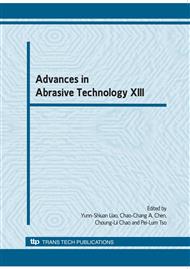p.505
p.511
p.515
p.521
p.527
p.533
p.539
p.545
p.551
Using Electro-Rheological Chain Structure to Improve SKD11 Surface
Abstract:
In the past half century, EDM (electrical discharge machining) is one of the most popular methods for manufacturing casting and plastic injection molds. Unlike other traditional mechanical cutting methods, EDM removes materials away by sparks, which leads to high temperature and pressure. As a result, it has no restriction to hardness because of its non-contact property. However, there will be recast layers on the surface of work-pieces and thus the surface need improved. In order to decrease the surface roughness, we added different powders into dielectric to become ERF (electrorheological fluid). By rotating spindle, the chain structures of ERF can improve surface of SKD11. The result shows that, when the gap is 100μm and electrode φ2, starch has 61% improvement rate and Al2O3 has 14.97%.
Info:
Periodical:
Pages:
527-532
Citation:
Online since:
August 2010
Authors:
Keywords:
Price:
Сopyright:
© 2010 Trans Tech Publications Ltd. All Rights Reserved
Share:
Citation:


